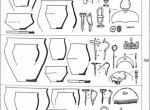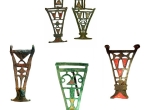Kiev Culture
Kiev Culture, archaeological culture recorded between the turn of 2nd and 3rd centuries (B2/C1) and the onset of 5th century (D1) across a broad territory in the forest-steppe zone of East Europe: from the Middle Dnieper region in the west as far as the Osokol River in the east. According to a more recent tendency the territorial range of K.C. was even larger, extending eastward to the Middle Volga near the confluence with the Samara River, to Podlahia in the west, and the Western Dvina River in the north. K.C. was identified in late 1940 – early 1950s by V. N. Danilenko. At present the best investigated sites are those in the basin of the Desna River and also on the Middle and Upper Dnieper River. Based on the variation in dwelling structure and pottery forms K.C. is distinguished into a number of local groups: the Middle and Upper Dnieper, the Desna, and the Eastern-Left Bank. Presumably they emerged as a result of fusion of traditions typical for groups of late Zarubintsy Culture. K.C. declined prior to the rise of some early medieval archaeological cultures (Kolochin, Penkovka). Some researchers (V. V. Sedov, I. P. Rusanova, O. M. Prikhodniuk, M. B. Shchukin) have come to question the genetic relationship of K.C. and the early Slav cultures. K.C. was under a strong impact of the neighbouring Cherniakhiv Culture, as documented by finds of Roman imports (amphorae, Roman coins) and objects from the Cherniakhiv Culture sphere (pottery, personal ornaments, dress accessories).
Settlements of KC. are less than 2 ha in area and occupy the first or the second floodplain terrace, less often – elevations within the floodplain. Dwellings have the form of single-room dugouts with a superstructure in a log or a posted design, most often with an open hearth. More commonly encountered housekeeping features include pit-cellars and ovens. Cemeteries are found next to settlements. With archaeological evidence on the burial custom scarce it is still imperfectly understood. The prevailing form of burial was cremation, rarely accompanied by grave goods. The number of known inhumations is very small.
The main category of find recorded in K.C. sites is coarse hand-built pottery (fig. 1.), mostly plain, and if decorated – with a design of pits or incisions to the upper part of the vessel. Finer (polished) wares (mostly basins), more typical during the early stages of development of K.C., are virtually unseen at its close, replaced by polished wheel-made Cherniakhiv pottery. Objects of daily use include assorted spindlewhorls, loom weights, polishers and implements made of bone (awls and combs). Metal objects in K.C. deposits sites are extremely rare. Next to objects of daily use (knives, perforators, awls, etc.) and military equipment, there are also brooches (with a high catchplate, tendril forms, Almgren VII), belt buckles, personal ornaments (pendants, rings, bracelets). Fairly typical for K.C. are objects decorated with champlevé enamel (brooches - fig. 2., lunula pendants, bracelets, chain links, plastic pendants), observed during the early stages of Kiev Culture and in evidence until its end. Enamelled brooches have different forms: strongly profiled, triangular, horseshoe, circular. In recent years the number of finds of champlevé enamels has increased significantly, mostly thanks to metal detector use.
The chronology of K.C. falls into three stages. Stage I (late 2nd/early 3d – mid-3rd century) when the pottery retains several features typical for late Zarubintsy Culture, with some Przeworsk elements →Przeworsk Culture as well. Stage II – the longest (second half of 3rd – mid-4th c.) – reflects a strong impact from Cherniakhiv traditions on the K.C. population as expressed by the presence of a large quantity of wheel-made pottery and personal ornaments. Also observed at this time is a series of innovations, both in the pottery and in personal ornaments. Finally, Stage III (mid-4th – early 5th century) is a time of a further intensification of Kiev C.-Cherniakhiv, but with pottery assemblages featuring forms close to early Kolochin Culture ceramics.
Kyryllo Myzgin
Literature: В.Н. Даниленко, Пізньозарубінецькі пам’ятки київського типу, Археологія, no 19, 1976; В.В. Седов, Происхождение и ранняя история славян, Москва 1979; Р.В. Терпиловский, Ранние славяне Подесенья III-V вв., Киев 1984; Р.В. Терпиловский, Н.С. Абашина, Памятники киевской культуры, Киев 1992; Е.В. Максимов, Р.В. Терпиловский, Киевская культура, [in:] И.П. Русанова, Э.А. Сымонович (eds.) Славяне и их соседи в конце І тысячелетия н.э. – в первой половине І тысячелетия н.э., Москва 1993; А.М. Обломский, Днепровское лесостепное Левобережье в позднеримское и гуннское время (середина III – первая половина V вв.), Москва 2002; Р.В. Терпиловский, Славяне Поднепровья в первой половине І тысячелетия н.э., Lublin 2004; Восточная Европа в середине І тысячелетия н.э. [in:] А.М. Обломский, И.О. Гавритухин (eds.), серия «Раннеславянский мир», вып. 9, Москва 2009; М.Б. Щукин, Реплика по поводу «киевской культуры», [in:] Д.А. Мачинский (ed.) Европейская Сарматия, Санкт-Петербург 2011.
-
 full resolution
full resolution
Fig. 1. Typical artefacts for Kiev culture.
-
 full resolution
full resolution
Fig. 2. Enemeled brooches.


